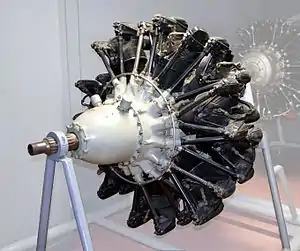Gnome-Rhône 14N
The Gnome-Rhône 14N was a 14-cylinder two-row air-cooled radial engine designed and manufactured by Gnome-Rhône. A development of the pre-war Gnome-Rhône 14K, the 14N was used on several French and German aircraft of World War II.
| Gnome-Rhône 14N | |
|---|---|
 | |
| Type | Radial engine |
| National origin | France |
| Manufacturer | Gnome et Rhône |
| First run | 1937 |
| Major applications | Bloch MB.150 Messerschmitt Me 323 Amiot 351 Lioré et Olivier LeO 45 |
| Developed from | Gnome-Rhône Mistral Major |
| Developed into | Gnome-Rhône 14M |
Design and development
Facing criticisms over the 14K's reliability, Gnome-Rhône undertook a major upgrade of its 14-cylinder design, using different materials for the pistons and valves, and enlarging cooling surfaces by 39%.
The new 14N was introduced in 1937 and was quickly adopted on several aircraft models. In 1939, minor improvements allowed Gnome-Rhône to increase the compression ratio from 6.1:1 to 6.8:1, which resulted in increased power for wartime production aircraft.
The 14N was further developed into the Gnome-Rhône 14R featuring a 2-stage supercharger, but this type was not widely used until after World War II as production of improved engines was prohibited by the terms of the armistice with Germany.
Postwar the 14R was developed into a 28 cylinder high capacity engine as the Gnome-Rhône 28T-1, essentially two 14R-24 engines back to back driving co-axial contra-rotating propeller shafts.[1]
Variants
Data from:Aircraft engines of the World 1945,[2] Aircraft engines of the World 1946[1]
- 14N-2:LH rotation, 770 kW (1,050 PS)
- 14N-3:RH rotation version of -2
- 14N-10:LH rotation, 670 kW (910 PS)
- 14N-11:RH rotation version of -10
- 14N-16:LH rotation, 688 kW (935 PS)
- 14N-17:RH rotation version of -16
- 14N-20:LH rotation, 835 kW (1,135 PS)
- 14N-21:RH rotation version of -20
- 14N-44:LH rotation, 770 kW (1,050 PS)
- 14N-45:RH rotation version of -44
- 14N-48:LH rotation, 870 kW (1,180 PS)
- 14N-49:RH rotation version of -48
- 14N-50:LH rotation, 1,000 kW (1,400 PS)
- 14N-54:LH rotation, 920 kW (1,250 PS)
- 14N-55:RH rotation version of -54
- 14N-58:LH rotation, 870 kW (1,180 PS)
- 14N-59:RH rotation version of -58
Applications
- Amiot 351
- Amiot 354
- Bloch MB.131
- Bloch MB.151
- Bloch MB.152
- Bloch MB.155
- Bloch MB.170
- Bloch MB.174
- Bloch MB.175
- Bloch MB.220
- Breguet 891R Mars (2 × 14R)
- Farman F.222
- Latécoère 611
- Lioré et Olivier LeO 45
- Sud-Est SE.161 Languedoc
- Messerschmitt Me 323
- Koolhoven F.K.58
- PZL P.24
- PZL.43 Karaś
- SNCAO CAO.700 (2X 14N-48 + 2x 14N-49)
Specifications (14N-48)
Data from Aircraft engines of the World 1945[2]
General characteristics
- Type: Fourteen-cylinder two-row air-cooled piston engine
- Bore: 146 mm (5.75 in)
- Stroke: 165 mm (6.50 in)
- Displacement: 38.67 l (2,360 cu in)
- Length: 1,480 mm (58.27 in)
- Diameter: 1,290 mm (50.79 in)
- Dry weight: 620 kg (1,370 lb)
Components
- Valvetrain: Two inlet and two exhaust overhead valves per cylinder
- Supercharger: Single-stage single-speed centrifugal type supercharger
- Fuel system: Stromberg carburetor
- Fuel type: 87 octane rating gasoline
- Oil system: Pressure fed at 480 kPa (70 psi)
- Cooling system: Air-cooled
- Reduction gear: 0.5:1 planetary reduction gearing
Performance
- Power output:
- Take-off: 870 kW (1,180 PS) at 2,650 rpm
- Military: 780 kW (1,060 PS) at 2,400 rpm at 3,900 m (12,800 ft)
- Cruise: 630 kW (850 PS) at 2,100 rpm at 3,900 m (12,800 ft)
- Specific power: 22.45 kW/l (0.49 hp/in³)
- Compression ratio: 6.8:1
- Power-to-weight ratio: 1.4 kW/kg (0.85 hp/lb)
See also
- Pratt & Whitney R-1830 a comparable engine sometimes fitted as an alternative to the 14N on French designs
- BMW 801
- Bristol Hercules
- Bristol Taurus
- Fiat A.74
- Mitsubishi Kinsei
- Nakajima Sakae
- Piaggio P.XIX
- Shvetsov ASh-82
- Tumansky M-88
- Wright R-2600
References
| Wikimedia Commons has media related to Gnome-Rhône 14N. |
- Wilkinson, Paul H. (1946). Aircraft engines of the World 1946 (4th ed.). London: Sir Isaac Pitman & Sons Ltd.
- Wilkinson, Paul H. (1945). Aircraft engines of the World 1945 (3rd ed.). -New York: Paul H. Wilkinson.
- Danel, Raymond and Cuny, Jean. L'aviation française de bombardement et de renseignement 1918-1940 Docavia n°12, Editions Larivière
